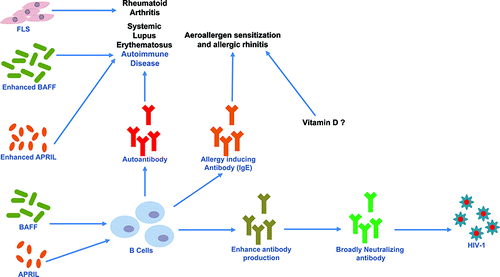Antibodies are key soluble mediators for host immunity against numerous pathogens. Antibodies work through direct neutralization, enhancing phagocytosis, triggering complement and activating immune cells. Dysregulation of antibody synthesis may lead to conditions such as seasonal allergic rhinitis, or protracted autoimmune diseases such as rheumatoid arthritis. Therapeutic and prophylactic antibodies emerged as effective tools to manage a broad range of infectious, non-infectious and autoimmune diseases. This issue of the International Reviews of Immunology showcases the interplay between pathogenic mechanisms underlying disease and therapeutic antibodies, respectively.
In the first review by Samy et al., the authors discuss the translational potential of B cell activating factor (BAFF) and a proliferation–inducing ligand (APRIL), essential for B cell development and antibody production in B cell-associated autoimmune diseases such as systemic lupus erythematosus (SLE), rheumatoid arthritis (RA) and so on. This review also discusses the outcome of BAFF and/or APRIL inhibition on SLE progression. Preclinical and clinical data support authors assertions ().
Figure 1. Antibodies in Pathogenesis and Prevention of Diseases. FLS, Fibroblast-like Synoviocytes; BAFF, B cell activating factor; APRIL, a proliferation–inducing ligand; IgE, Immunoglobulin E and HIV-1, Human immunodeficiency virus.

In the second review by Ganesan and Rasool, the authors discuss recent developments in understanding RA biology. The authors describe the critical role of Fibroblast-like synoviocytes (FLS) and FLS-induced factors in the pathogenesis of RA. The authors also discuss the possibility of inhibition of FLS function for development of new therapeutics for RA. However this concept needs careful evaluation before clinical translation, since FLS could be essential for other biological functions (immunity and/or bone and cartilage structure and function) ().
The third review, by Yaseen et al. discusses the possibility of controlling an infectious disease, AIDS caused by HIV-1. Currently, HIV-1 infection is treated to some extent by antiretroviral therapy (ART) which is not only causing a broad range of side effects, allowing also the emergence of ART-resistant HIV-1, but it is also very expensive. This article discusses broadly neutralizing anti-HIV-1 antibodies (BNAbs) as a possible future cost effective therapeutic agent. The authors also compared advantages and disadvantages over ART ().
Vitamin D plays a significant role in bone metabolism and immunity. The last review article of this issue by Aryan et al., is an extensive literature meta-analysis using various scientific research databases for understanding the possible association with aeroallergen sensitization (AS) and allergic rhinitis (AR), suggesting a correlation between the levels of vitamin D and AS and AR ().
Upcoming issues of the journal will focus on basic understanding of Host-Pathogen interaction and translational approaches to overcome infectious diseases.
References
- Samy E, Wax S, Huard B, Hess H, Schneider P. Targeting BAFF and APRIL in systemic lupus erythematosus and other antibody-associated diseases. International Reviews of Immunology 2017;36(1):3–19.
- Ganesan R, Rasool M. Fibroblast-like synoviocytes-dependent effector molecules as a critical mediator for rheumatoid arthritis: Current status and future directions. International Reviews of Immunology 2017;36(1):20–30.
- Yaseen MM, Yaseen MM, Alqudah MA. Broadly neutralizing antibodies: An approach to control HIV-infection. International Reviews of Immunology 2017;36(1):31–40.
- Aryan Z, Rezaei N, Camargo Jr. CA. Vitamin D status, aeroallergen sensitization, and allergic rhinitis: A systematic review andmeta-analysis. International Reviews of Immunology 2017;36(1):41–53.
